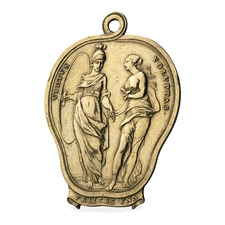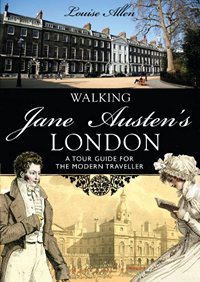The Georgian Gentleman’s Version of the Little Black Book
by Elizabeth Bailey
Women who fell from grace in the 18th Century had few options open to them. Get married with speed was top of the list. Preferably to the fellow with whom you did the deed, but frankly anyone of respectability would do.
If Darcy had not intervened to get Lydia married to wicked Wickham, as Lizzie Bennet points out, not only Lydia, but her four sisters would have been tainted and probably doomed to spinsterhood since they had no money to bribe a prospective bridegroom into overlooking the disgrace.

A page from Harris’s List
The Bennet girls were lucky. In reality, the family would likely have disowned Lydia. When Wickham tired of her, she was young and pretty enough to have found herself another protector. As time went on, Lydia might have drifted in the direction of Covent Garden where she could well have found herself portrayed in a couple of extremely frank paragraphs in the annual publication of Harris’s List of Covent-Garden Ladies.
This fascinating little volume was started in 1757 by one Samuel Derrick, as a venture to get himself out of debtor’s prison. His lively descriptions of the ladies who made themselves available for a gentleman’s amours proved so popular that he not only procured his release, but he started a phenomenon that continued until 1795.
Almost all the ladies spoken of as being of good education evidently fell into “the life”, as it was popularly called, by way of seduction and subsequent abandonment.
Like Miss Char-ton (note the missing letter, a thinly veiled anonymity) of No. 12, Gress Street, who “came of reputable parents…yet the address of a designing villain, too soon found means to ruin her; forsaken by her friends, pursued by shame and necessity; she had no other alternative…”
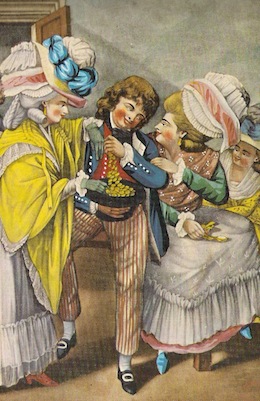
Prostitutes propositioning a sailor
Seduction was not confined to the educated classes. There was Miss Le-, of Berwick-Street, Soho, who “was debauched by a young counsellor, from a boarding-school near town, where she was apprentice.”
Then there was Miss We-ls, of No. 35, Newman-Street, daughter of a Welsh farmer, who is described as being “as wild as a goat, of a sandy colour, her features are small, and is a tight little piece.” She was sent to London when young where “a young gentleman ingratiated him so far into her graces, as to gain her consent to make him happy by her ruin, under a promise of marriage” and then he subsequently “abandoned her to the reproaches and calumny of a merciless world”.
The majority of the ladies featured in this entertaining little black book for your pleasure-seeking young buck were in their teens or early twenties. An example is Miss Townsend, nineteen, of whom we learn that “the use of the needle first fired this lady’s imagination with the use of a certain pin”. This sort of witty euphemism abounds.
Perhaps it is not surprising that the anodyne of choice for a number of the ladies is strong liquor. Like Miss Godfrey, a commanding female, who “will take brandy with any one, or drink and swear, and though but little, will fight a good battle.”
The women are delineated in detail, depending on their particular attractions: “she is amorous to the greatest degree, and has courage enough not to be afraid of the largest and strongest man that ever drew weapon in the cause of love”. Or non-attractions, as “but a middling face, with large features, a coarse hand and arm, and in stature short and clumsy”, but she is “an excellent bedfellow”.
Their looks are described: “of a middle size, black eyes, plump made and her skin good” or another with “fine blue eyes that are delicious”. We are told about good teeth and “sweet breath”, in a day where these were rare. We hear about “yielding limbs, though beautiful when together, are still more ravishing when separated”.
Disposition is mentioned, whether she is “agreeable” or “animated with no small degree of vanity” or indeed “a pompous heroic girl, without either wit or humour”. There is a figure to suit every taste, and an accommodation for every sexual whim. We learn whether or not she has a keeper (which doesn’t stop any lady selling her favours elsewhere) and what it may cost our young man about town to enjoy her charms.
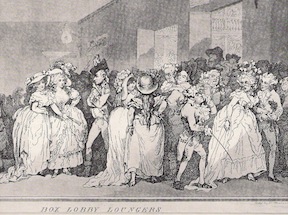
Prostitutes angling for business in the lobby of a theatre
One or two guineas appears the norm, with here and there a more expensive luxury on offer. The genteel Miss Le- above, who was led into sin, is only seventeen and “has a piece of the termagant about her”, but she commands three or four guineas for her services, which include birching for those so inclined. While Miss – of Wardour Street, who is “but newly arrived” and “darts such irresistible glances as can scarcely fail to engage the hearts of the beholders” will not accept less than five guineas. Mrs Ho-fey, on the other hand, who “calls forth all her powers to give delight with uncommon success” will happily settle for half a guinea.
A guinea (one pound, one shilling) seems a pathetic sum to us. Yet these women were the middling class of prostitute. They could not aspire to the heights of high-class courtesans like the later Harriette Wilson, whose clients included the Duke of Wellington, but they were a good deal better off than the street corner girls who plied their trade for a few pence, or a few shillings at best.
But whether they earned a pittance or a fortune, many women ended up selling their bodies to make ends meet. There were 50,000 prostitutes in London in 1797, according to a contemporary magistrate’s account. That statistic argues a lack of opportunities for women to find gainful employment. The better bred, the fewer the options.
It’s tempting to withhold sympathy for our Covent-Garden ladies when you convert their earnings to the present day. In today’s money, a guinea is worth around £60. A lady’s maid was paid less than that in a year, and no doubt worked a lot harder. While Miss Le- with her five guineas was getting buying power to the tune of our £300 every time she lay flat on her back!
What’s more, these ladies of the night could afford to please themselves how they lived, which was more than could be said for most wives, be their husbands lord or boot boy. They lived in comfortable apartments, had a great deal of freedom, could pick and choose among their clientele, and enjoy all the entertainments on offer in the shops and theatres of the time. And all at the trifling cost of respectability.
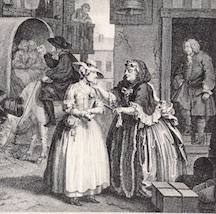
Hogarth—a bawd from a brothel enticing a country girl newly arrived in London
The downside was the future. The lifestyle was no sinecure. There are very few females over thirty in Harris’s List. Assuming one could avoid a dose of “the pox” or any other disease and live, what to do when the charms of youth faded? How many of them were canny enough to salt away a quantity of takings as insurance?
A few, one assumes, if they had garnered sufficient fortune, might be lucky enough to marry. Others are mentioned as having moved into brothel-keeping themselves. But the rest?
What happened to Sally Robinson, who was given five shillings at the age of fifteen to cure her of the clap “which she got from her deflowerer”? On the town in 1761, what hope had “a tall, fat girl” of any kind of living thirty years later? Or Kitty Buckley, who was one of the few older females and already 35 in 1761? She was “reported to have ruined twenty keepers” because she was “as wicked as a devil, and as extravagant as Cleopatra”. Since she had been in the bailiff’s hands about three times a year, did she end her days in prison?
While Harris’s List is a delight in many ways, there is something a little distasteful in the warts-and-all public exposure of a whole generation of unfortunate females, whose only mistake was to succumb to the lure of sensual gratification.
Besides marriage or prostitution, was there any other way out for the fallen woman? If they were lucky, or had kind and generous relatives, there was hope. Transported to another place, perhaps with an allowance, they could start a new life under an assumed name – but with the shadow of the past always ready to catch up with them.
This is of course a familiar theme in our modern take on the historical romance. Our heroine is plucked from this life of shame and obscurity by the love of a good man. What better way to compensate her for enduring such punishment for what was, to our twenty-first century thinking, perfectly natural behaviour?
As for the luscious Covent-Garden Ladies, who had the gumption to use the only means they had of making a decent living – good for you, ladies!
About A Lady In Name
On discovering she is the illegitimate daughter of a peer of the realm, Lucy Graydene, bereft and grieving, sets out to confront Lord Pennington with the result of his misdeeds. She finds instead his autocratic heir, Stefan Ankerville, and is dragged willy-nilly into the new earl’s unconventional family. Lucy is driven to battle for her independence while she struggles against the venom of the half-sister she never knew she had.
When the secrets of Lucy’s past begin to unravel, she is reluctantly obliged to rely on Stefan’s help. Can Lucy overcome a dangerous attraction to the earl, with whom an alliance is impossible? Or is there a faint hope of happiness in the hidden truth of her origins?
Excerpt
The hubbub of a busy inn penetrated dimly into the quiet of the upstairs parlour. It was a small apartment, designed for privacy rather than comfort, and furnished with the minimum of necessities. A chill hung in the January air, little eased by the meagre warmth from a fire in the grate, but the solitary occupant of the room appeared unaffected by this circumstance, although her aspect was far from relaxed.
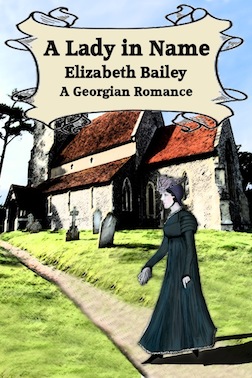 She was seated on one of the straight high-backed chairs placed about the heavy oaken table at which travellers were encouraged to partake of refreshments, but she had not thought to move it nearer to the hearth. Nor was there any sign that she had availed herself of the innkeeper’s offerings to assuage either hunger or thirst. She was clad in a plain black greatcoat, and a simple black bonnet, unadorned, concealed her hair and a good deal of her face. She sat perfectly upright and still, except for her gloved hands, which she repeatedly clasped and unclasped where they lay in her lap.
She was seated on one of the straight high-backed chairs placed about the heavy oaken table at which travellers were encouraged to partake of refreshments, but she had not thought to move it nearer to the hearth. Nor was there any sign that she had availed herself of the innkeeper’s offerings to assuage either hunger or thirst. She was clad in a plain black greatcoat, and a simple black bonnet, unadorned, concealed her hair and a good deal of her face. She sat perfectly upright and still, except for her gloved hands, which she repeatedly clasped and unclasped where they lay in her lap.
From time to time, her eyes flickered to the door, as if in the expectation of its opening at any moment. And once she cast a frowning glance at the case clock on the mantel, which was dragging its way about the eleventh hour, its steady ticking pulling her out of her unquiet thoughts.
She scarcely knew what she was doing here, and the longer she waited for an arrival upon which she could place no real dependence, the stronger grew her anxieties. What had she to hope for, thrusting herself upon the notice of Lord Pennington? The man who had repudiated her three and twenty years ago was unlikely to greet her sudden appearance with complaisance. Nor could she imagine the intervening years had changed one hard-hearted enough to reject all responsibility for the consequences of his libertine conduct. Despite his cloth, Papa’s dictum, frequently uttered, had been that a leopard never changes his spots.
The remembrance caught at her heartstrings, turning a knife in the wound. Papa—so she must always think of him. She churned again with the futile yearnings that had plagued her from the instant of his uttering the fateful confession.
If only he had not chosen to reveal the horrid truth of her origins. If only he had been spared the necessity. If only the Almighty had spared him. And most painful of all, if only Lucy had been more alert to his weakness after the dreadful downpour.
It had caught him on a visit to Mrs Mimms—one of the poorest of Papa’s parishioners, her cottage situated a good five miles from Upledon vicarage with no vestige of shelter between. The dread picture of his return, his clothes dripping, his horse streaming in the deluge, had haunted Lucy from the onset of his short and fatal illness.
In vain had Papa protested at her rage of tears, his once round tones faint with effort as he drew each difficult breath. ‘My child, you could not have known. Recollect that I was well for days after the incident.’
‘Apparently well,’ Lucy had argued, fierce against the inevitable doom she was powerless to prevent. ‘You were pale, Papa. And you could not stand for long without a rest. I see it now. I should have seen it then.’
‘Lucy, there is nothing you could have done. It is God’s will, and you must accept it.’
But Lucy was incapable of trusting to the will of a deity who could deprive her at one stroke of her sole source of loving comfort and the entirety of her life’s belief. Oh, Papa, if only you had not told me! Except that if he had not, he would not have been the man she had known and cared for as her father: compassionate, patient, and the exemplar of “the milk of human kindness” demanded by his calling. Else he could not have taken to his heart and raised as his own the child of dubious parentage Lucy now knew herself to be.
Caught in the turmoil of her unhappy thoughts, the opening of the door took Lucy unawares. She jumped, her eyes flying to the aperture where a man stood revealed. She took in a tall frame enveloped in the grey of a many-caped greatcoat, one slender hand holding to the door handle. From under a dark beaver hat, a steel gaze pierced her in a countenance considerably younger than Lucy had anticipated.
Startled, she shot out of her chair, starting forward a step or two, a riot of question leaping to her tongue.
‘Oh! Surely you cannot be—? There must be some mistake! Unless—have you been sent by him? Or, no—perhaps you have mistaken the room?’ Lucy gathered her scattered thoughts. ‘This is a private parlour, sir.’
The gentleman made no move to vacate the room, but the disconcerting violence of his regard lessened a trifle.
‘Miss Graydene?’
‘Yes, I am she. But you—I was expecting Lord Pennington.’
‘I am Pennington.’
 Available
Available
AMAZON UK • AMAZON US
About the Author
Elizabeth Bailey grew up in Africa with unconventional parents, where she loved reading and drama. On returning to England, she developed her career in acting, theatre directing and finally writing. Elizabeth has 18 novels published by Harlequin Mills & Boon and recently began a Georgian historical crime series of which the first two books were published by Berkley (Penguin US). But since she still loves romance, Elizabeth is delighted with the opportunity to publish her work independently.
Contacts
Website • Facebook • Twitter • Blog



